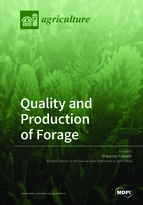Quality and Production of Forage
A special issue of Agriculture (ISSN 2077-0472).
Deadline for manuscript submissions: closed (30 June 2019) | Viewed by 109174
Special Issue Editor
Interests: animal nutrition; poultry nutrition; feed science; feed technology
Special Issues, Collections and Topics in MDPI journals
Special Issue Information
Dear Colleagues,
The present Special Issue will welcome contributions of both reviews and original articles. The aim is to receive scientific contributions from different countries (Europe, North and South America, Africa, Asia, Australia). The contributions will investigate the quality and production of the major and new forages in use around the world (including grasses, cereal or pulse crops used as forage); the influence of forage characteristics on animal performances and products quality; as well as the forage qualitative aspects as affected by conservation methods (hay and silage).
Manuscripts (reviews and original articles) may include, but are not limited to, the impact of the following topics:
- Innovative strategies for forage production;
- Forage quality and animal productive performance;
- Animal products as affected by forage in diet;
- Fertilization of forage crops;
- Crop production intensification for sustainable agriculture;
- Forage yield and quality under different environmental conditions;
- Forage conservation method.
Guest Editor
Manuscript Submission Information
Manuscripts should be submitted online at www.mdpi.com by registering and logging in to this website. Once you are registered, click here to go to the submission form. Manuscripts can be submitted until the deadline. All submissions that pass pre-check are peer-reviewed. Accepted papers will be published continuously in the journal (as soon as accepted) and will be listed together on the special issue website. Research articles, review articles as well as short communications are invited. For planned papers, a title and short abstract (about 100 words) can be sent to the Editorial Office for announcement on this website.
Submitted manuscripts should not have been published previously, nor be under consideration for publication elsewhere (except conference proceedings papers). All manuscripts are thoroughly refereed through a single-blind peer-review process. A guide for authors and other relevant information for submission of manuscripts is available on the Instructions for Authors page. Agriculture is an international peer-reviewed open access monthly journal published by MDPI.
Please visit the Instructions for Authors page before submitting a manuscript. The Article Processing Charge (APC) for publication in this open access journal is 2600 CHF (Swiss Francs). Submitted papers should be well formatted and use good English. Authors may use MDPI's English editing service prior to publication or during author revisions.
Keywords
- Forage quality
- Animal feeding
- Organic and sustainable agriculture
- Anti-nutritional factors
- Biomass production
- Organic and inorganic fertilizers on forage quality






